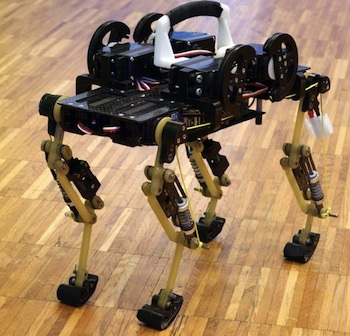Science Fiction
Dictionary
A B C D E F G H I J K L M N O P Q R S T U V W X Y Z
Cheetah Cub Robot From PKD's Android Dreams

This is the stuff of Philip K. Dick's dreams - or at least those of the androids in his 1968 novel Do Androids Dream of Electric Sheep?.

(A small robotic cat)
Even though it doesn’t have a head, you can still tell what kind of animal it is: the robot is definitely modeled upon a cat. Developed by EPFL’s Biorobotics Laboratory (Biorob), the “cheetah-cub robot,” a small-size quadruped prototype robot, is described in an article appearing today in the International Journal of Robotics Research. The purpose of the platform is to encourage research in biomechanics; its particularity is the design of its legs, which make it very fast and stable. Robots developed from this concept could eventually be used in search and rescue missions or for exploration.This robot is the fastest in its category, namely in normalized speed for small quadruped robots under 30Kg. During tests, it demonstrated its ability to run nearly seven times its body length in one second. Although not as agile as a real cat, it still has excellent auto-stabilization characteristics when running at full speed or over a course that included disturbances such as small steps. In addition, the robot is extremely light, compact, and robust and can be easily assembled from materials that are inexpensive and readily available.
(Robotic 'Cheetah cub' video)
As Isidore says in Philip K. Dick's 1968 classic Do Androids Dream of Electric Sheep:
""What about an exact electric duplicate of your cat? We can have a superb handcrafted job by Wheelright & Carpenter in which every detail of the old animal is faithfully repeated..."
Via PopSci.
Scroll down for more stories in the same category. (Story submitted 6/16/2013)
Follow this kind of news @Technovelgy.| Email | RSS | Blog It | Stumble | del.icio.us | Digg | Reddit |
Would
you like to contribute a story tip?
It's easy:
Get the URL of the story, and the related sf author, and add
it here.
Comment/Join discussion ( 0 )
Related News Stories - (" Robotics ")
Artificial Skin For Robots Is Coming Right Along
'... an elastic, tinted material that had all the feel and appearance of human flesh and epidermis.' - Harl Vincent (1934)
Robot Guard Dog On Duty
I might also be thinking of K-9 from Doctor Who.
Wearable Artificial Fabric Muscles
'It is remarkable that the long leverages of their machines are in most cases actuated by a sort of sham musculature...' HG Wells, 1898.
Dancing Robots Taught Dance Moves
'A clockwork figure would be the thing for you...' Jerome K. Jerome, 1893.
Technovelgy (that's tech-novel-gee!) is devoted to the creative science inventions and ideas of sf authors. Look for the Invention Category that interests you, the Glossary, the Invention Timeline, or see what's New.
Science Fiction
Timeline
1600-1899
1900-1939
1940's 1950's
1960's 1970's
1980's 1990's
2000's 2010's
Current News
The Zapata Air Scooter Would Be Great In A Science Fiction Story
'Betty's slapdash style.'
Thermostabilized Wet Meat Product (NASA Prototype)
There are no orbiting Michelin stars. Yet.
Could Crystal Batteries Generate Power For Centuries?
'Power could be compressed thus into an inch-square cube of what looked like blue-white ice'
India Ponders Always-On Smartphone Location Tracking
'It is necessary... for your own protection.'
Amazon Will Send You Heinlein's Knockdown Cabin
'It's so light that you can set it up in five minutes by yourself...'
Is It Time To Forbid Human Driving?
'Heavy penalties... were to be applied to any one found driving manually-controlled machines.'
Replace The Smartphone With A Connected Edge Node For AI Inference
'Buy a Little Dingbat... electropen, wrist watch, pocketphone, pocket radio, billfold ... all in one.'
Artificial Skin For Robots Is Coming Right Along
'... an elastic, tinted material that had all the feel and appearance of human flesh and epidermis.'
Robot Guard Dog On Duty
I might also be thinking of K-9 from Doctor Who.
Wearable Artificial Fabric Muscles
'It is remarkable that the long leverages of their machines are in most cases actuated by a sort of sham musculature...'
BrainBridge Concept Transplant Of Human Head Proposed
'Briquet’s head seemed to think that to find and attach a new body to her head was as easy as to fit and sew a new dress.'
Google's Nano Banana Pro Presents Handwritten Math Solutions
'...copy was turned out in a charming and entirely feminine handwriting.'
Edible Meat-Like Fungus Like Barbara Hambly's Slunch?
'It was almost unheard of for slunch to spread that fast...'
Sunday Robotics 'Memo' Bot Has Unique Training Glove
'He then started hand movements of definite pattern...'
Woman Marries Computer, Vonnegut's Dream Comes True
'Men are made of protoplasm... Lasts forever.'
Natural Gait With Prosthetic Connected To Nervous System
'The leg was to function, in a way, as a servo-mechanism operated by Larry’s brain...'
